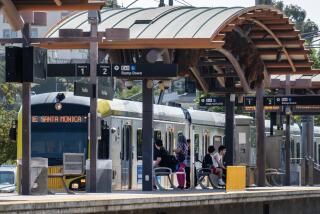Los Angelesâ Transit Needs
In response to Peter H. Kingâs column (âMetrolink to L.A.: All Aboard Pleaseâ Nov. 11):
Californiaâs population has grown 25% over the past 10 years. The number of drivers has increased by 35% and the number of vehicle miles traveled has increased by 60%.
These numbers underscore the need to develop a comprehensive regional transportation system that includes a combination of solutions. Metro Rail (subway and light rail), Metrolink (commute rail), buses, highways, car-pool lanes, bikeways and telecommuting are some of the available options that combined with land-use alternatives will help make Los Angeles a more livable place.
The Los Angeles County Transportation Commission (LACTC) is in the process of building that system, which already is offering new transportation alternatives to commuters, but, most importantly, it is the transportation system that will help Los Angeles enter the new century.
Metrolink ridership has surpassed transportation plannersâ estimates for the first months of service. Planners forecasted 2,000 daily riders for the start-up phase of Metrolink. The average ridership in the first three weeks of revenue service was 3,300 per day. Ridership will continue to increase once new stations are added to the system and the Metro Red Line subway opens, providing easy connections to downtown destinations. By 1995 when the system will have 60 stations open and nine routes, the ridership is estimated to increase to 23,300 a day.
Those still in doubt of Metrolinkâs cost savings compared to solo commuting should be aware of recent estimates made by the American Automobile Assn. indicating that riding Metrolink is cheaper than driving to work. A round-trip from Moorpark to Union Station in downtown Los Angeles costs $8 to Metrolinkâs monthly pass users. The associationâs statistics show that a driver pays $9.12 in operating costs and $29.14 in car ownership expenses--a total of $38.26--for the same trip.
We have listened to suggestions made by patrons regarding Metrolink prices, and have reviewed the zone structure to more accurately reflect the number of miles traveled by passengers.
NEIL PETERSON
Executive Director
LACTC
More to Read
Sign up for Essential California
The most important California stories and recommendations in your inbox every morning.
You may occasionally receive promotional content from the Los Angeles Times.










